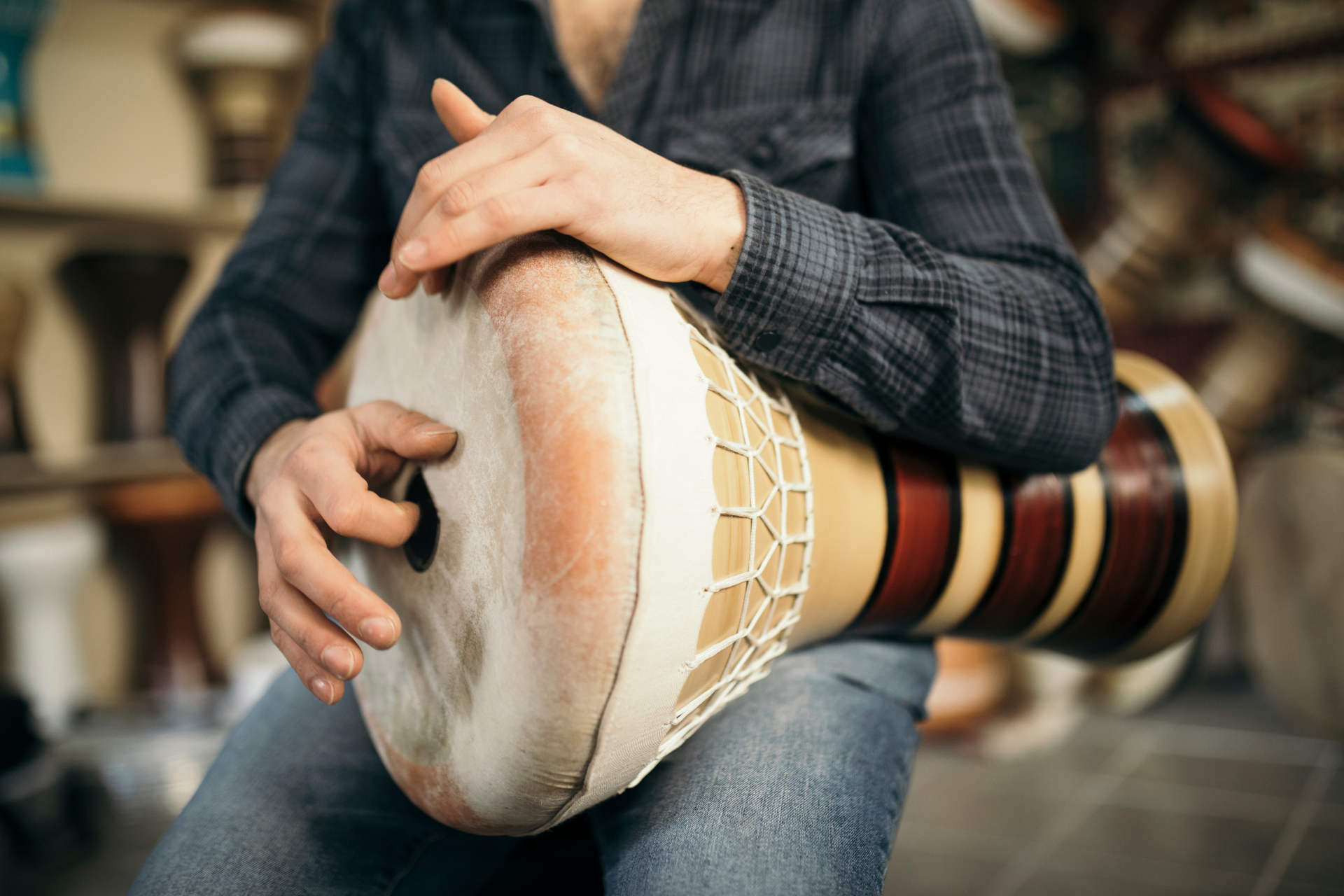General Articles
Darbuka vs Other Hand Drums: Understanding What Makes It Unique
Hand drums have been an essential part of musical traditions around the world for centuries. Among these, the darbuka holds a special place, especially in Middle Eastern, North African, and Mediterranean music. While many percussion instruments share similar characteristics, each hand drum offers a unique sound, playing technique, and cultural significance. This article compares the darbuka with other prominent hand drums, including the Persian tonbak, highlighting what sets the darbuka apart.
What is the Darbuka?
The darbuka, sometimes called the goblet drum, is a single-headed drum with a goblet-shaped body. Traditionally made from materials like clay, metal, or ceramic, modern darbukas can also use synthetic materials. Its distinct shape allows for sharp, resonant tones as well as deep bass sounds, making it versatile for both rhythm and expressive playing.
The darbuka is played with the hands using finger taps, slaps, and rolls. It is popular in Arabic, Turkish, Balkan, and other musical genres and is known for its crisp, articulate sound that can cut through ensemble music.
Overview of Other Common Hand Drums
Hand drums vary widely, but a few are especially notable for their rich cultural heritage and unique sound qualities:
-
Tonbak (Persian Drum): Also known as tombak or zarb, the tonbak is the principal percussion instrument of Persian classical music. It has a larger body than the darbuka, is traditionally made of wood, and uses a single head made from animal skin. The tonbak’s sound is warm and deep, with the ability to produce subtle tonal variations.
-
Djembe: Originating from West Africa, the djembe is a large, rope-tuned drum played with bare hands. It has a wide dynamic range and is known for its loud, vibrant sound.
-
Cajón: While technically a box drum played by slapping the front face, the cajón is often compared to hand drums due to its percussive nature. It is popular in flamenco, Afro-Peruvian music, and contemporary genres.
-
Bongo Drums: Originating from Cuba, bongos are a pair of small, open-bottomed drums played with the fingers and palms. They produce high-pitched, sharp tones and are used widely in Latin music.
Comparing the Darbuka and the Tonbak: Key Differences
The darbuka and the tonbak are often compared because they both have strong ties to Middle Eastern music traditions, but they have significant differences:
Shape and Construction
The darbuka has a goblet shape, which helps produce a sharp “doum” bass sound from the larger bottom cavity and crisp “tek” and “ka” sounds from the edge of the drumhead. It is often made from metal or ceramic, which contributes to its bright, resonant tone.
The tonbak, by contrast, has a cylindrical wooden body that is wider than the darbuka’s narrow neck. Its drumhead is typically goat or fish skin stretched over the top. The wooden body gives the tonbak a warmer, more mellow sound with less sharpness than the darbuka.
Playing Technique
The darbuka is played primarily with finger taps and slaps on the drumhead’s edge and center, emphasizing quick, articulate sounds. Players use combinations of “doum” (bass tone), “tek” (high tone), and “ka” (slap tone) to create complex rhythms.
Tonbak players use more varied hand techniques, including finger snaps, palm slaps, and sometimes even nail tapping. Tonbak playing often involves more subtle dynamics and tonal shifts, allowing the player to produce a wide range of expressive sounds.
Sound and Tonal Quality
The darbuka’s tone is bright and penetrating, often described as sharp and crisp. It can cut through other instruments in an ensemble, making it ideal for leading rhythmic patterns in folk and dance music.
The tonbak produces softer, warmer tones with a greater emphasis on nuanced tonal expression. Its sound is less about cutting through an ensemble and more about blending with melodic instruments, especially in traditional Persian music.
Role in Music
The darbuka is frequently used in energetic, rhythmic dance music and popular styles across the Middle East and North Africa. It often provides the main rhythmic pulse and can be a solo instrument in virtuosic performances.
The tonbak is primarily found in Persian classical and traditional music, where it serves as a sensitive rhythmic accompaniment. Its subtle dynamics complement the intricate melodies of Persian instruments such as the tar and santur.
How the Darbuka Stands Out Among Other Hand Drums
Versatility and Adaptability
The darbuka’s unique shape and bright tone give it versatility. It is used in traditional Middle Eastern music, modern pop, fusion, and even electronic genres. Unlike the tonbak, which is deeply tied to Persian music, the darbuka has found a place in various musical cultures worldwide.
Portability and Durability
Darbukas made of metal or synthetic materials are durable and easy to transport, which adds to their popularity among travelling musicians. In contrast, the tonbak’s wooden body and delicate skin head require careful handling and are more sensitive to environmental changes.
Distinct Playing Style
The fast finger techniques and crisp sound of the darbuka allow for intricate rhythmic patterns that can be both hypnotic and danceable. This style contrasts with the tonbak’s more melodic and subtle approach, offering players a different kind of expression.
Similarities Between Darbuka and Other Hand Drums
Despite differences, many hand drums share features that connect them musically and culturally:
-
Both darbuka and tonbak are hand-played and use finger and palm techniques.
-
They serve as essential rhythmic instruments in their respective music traditions.
-
Both allow for expressive dynamics and nuanced tone production.
-
Like the djembe and bongos, they often accompany dance and community gatherings.
Choosing the Right Drum for You
When deciding between the darbuka, tonbak, or other hand drums, consider:
-
Musical Style: If you are interested in Middle Eastern dance or folk music, the darbuka is a natural fit. For Persian classical music, the tonbak is essential.
-
Sound Preference: The darbuka offers bright, sharp tones, while the tonbak provides warm, subtle sounds.
-
Playing Technique: Darbuka playing focuses on finger speed and precision. Tonbak playing requires nuanced hand movements and tonal control.
-
Portability: The darbuka is generally more durable and portable.
Caring for Your Darbuka and Tonbak
Proper care prolongs the life of any hand drum:
-
Avoid exposing wooden instruments like the tonbak to extreme humidity or temperature changes.
-
Keep drumheads clean and replace them if worn or damaged.
-
Store instruments in padded cases or bags.
-
Regularly check tuning and adjust as necessary.
Final Thoughts
While the darbuka and tonbak share common ground as hand drums central to Middle Eastern music, they offer distinctly different experiences in sound, playing technique, and cultural context. The darbuka’s bright, punchy tones and versatile playing style make it a standout in many musical genres, while the tonbak’s warm, subtle voice complements the refined melodies of Persian classical music.
Exploring these differences not only helps musicians choose the right instrument for their style but also deepens appreciation for the rich traditions behind each drum.
Explore a wide selection of darbukas, tonbaks, and other hand drums at Rhythm Music Shop, proudly serving Markham, Richmond Hill, North York, Scarborough, and the rest of the GTA.

